About three years ago, a friend gave me a 1995 Peg Perego GAUCHO kids ride on car. I was pretty excited, the kid’s first car, and it’s an off-roader. But after finding it was a 6v vehicle with an on-off pedal and needed near-continuous charging, the shine wore off. Its age and living outside also means the electrical system was less than reliable. Let upgrade this Perego Gaucho!
Limitations of the Gaucho
There are a few major problems with the standard Gaucho. The torque is limited by the 6v motors meaning off-roading, or long grass, is simply a no-no. As soon as you put two kids on, those batteries flatten pretty quickly. Driving the ride on is pretty difficult for a small child when the throttle is on or off. And the switches that control the drive speed, brake lights, and acceleration are not IP rated, and the contacts quickly oxidise.
Most of the current range of Peg Perego off-road toys are 12v and considerably more powerful than the 1995 version. I plan to overcome some or all of these Per Perego issues with a mixture of an upgrade to 12v and a more reliable method of controlling the car’s speed.
Motor Controller

The first step is to add a ‘solid-state’ motor controller which uses transistors to vary the output. These days a motor controller for light use is straightforward to find. I’m using the one in the picture above purchased from AliExpress. It was incredibly cheap, at £6.33 delivered. I couldn’t make my own controller for that price.
I’ve gone for a 60A controller. The car currently has a 40A fuse on each battery, but the peak draw is normally around 30A with 15A across each motor. Doubling the voltage will reduce the peak current draw, so this controller is more than man enough. This controller will need a pedal in addition, and we’ll come to that in a minute.
Upgrading the Perego wiring

The wiring is pretty much all going to need replacing. The original wiring utilises non-stabilised PVC, which degrades over time. Add years of high current draw and associated cable heating, and the resistance of the wires is just going up and up. For this project, I’m using cable and connectors from my favourite automotive supplier PoleVolt.
Tearing Down the Perego Gaucho
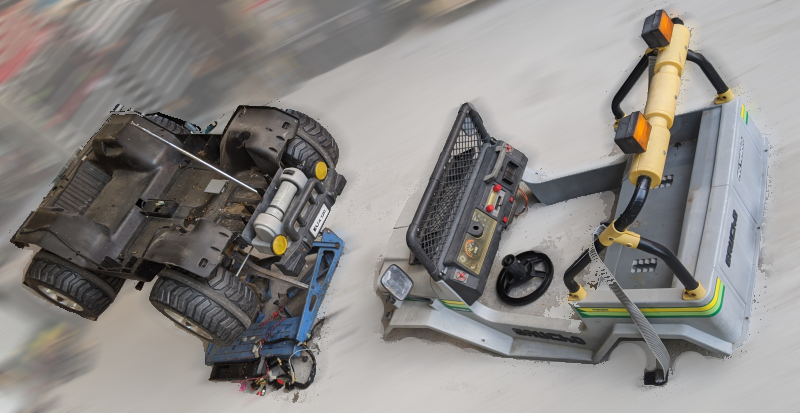
The vehicle is a mono chassis with a separate body shell. Okay, I’m stretching that description. It’s a plastic box on a plastic box. The design is simple, but clearly, some thought has gone into it. Before we can start to upgrade the Peg Perego Gaucho, we need to take it apart. The complete strip-down and removal of existing harnesses take about half an hour. I wish all my projects were this simple!
Throttle Pedal
To operate the motor controller, it needs a 0 to 5v input, which drives the motor duty between 0 and 100% duty. The controller is supplied with a 100k potentiometer across a 5v supply. This allows using a typical hall effect pedal that uses a sensor and magnet to change the output depending on its position.
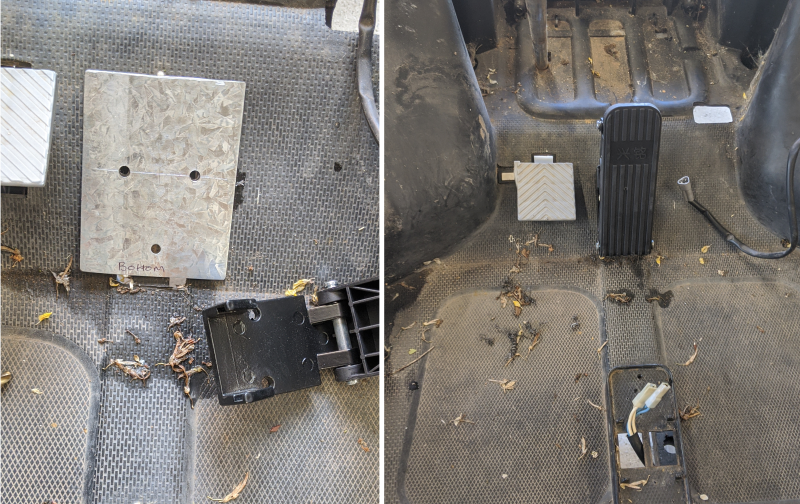
To fit this to the car, I’m using a fairly big plate on the underside to spread the load of small feet, putting the pedal to the floor. The plate on the left side of the picture is 2mm galvanised steel, so it should do the trick. The right-hand side of the picture shows the installed pedal.
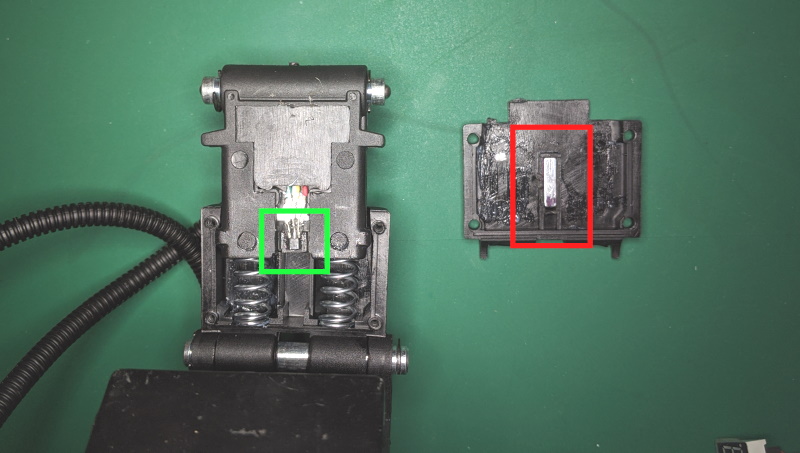
One thing that had me stumped for a long time was that the pedal would output 5v when the controller expected 0v. Finally, after much head-scratching and some Googling, I discovered a neat trick. Rotating the magnet (outlined in red) flips its relationship with the sensor (green outline) and gives me the output I need to drive the controller.
Assembling the Perego upgraded electronics

To keep the electronics dry, I plan to install the main parts inside a waterproof enclosure. As you can see, it’s a pretty tight fit! In this image, you can see some of the other electronics I’ve included. There is an inline CTEK connection to make charging that bit easier. There is also a ‘Master’ switch that controls a relay which will fully isolate the battery.

Once the electronics were all assembled, I offered them up to the car and made sure everything was working before the final mounting of the waterproof enclosure. Fortunately, everything worked the first time without a problem.
Switch Panel
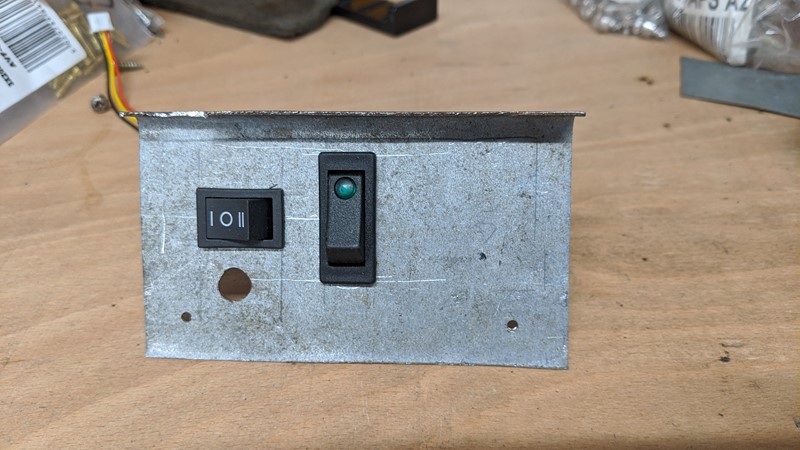
Perhaps a simple addition, this switch panel puts the controls right in front of the driver. The switch panel replaces the original Perego ‘tape cassette’ toy that was in the dash. Like all the changes being made, there is no permanent damage to the car. The original wiring and accessories can all be put back in place.
Putting it all back together
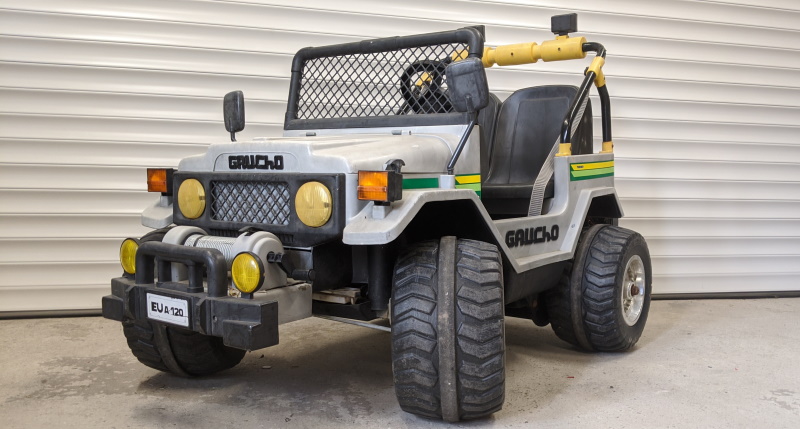
I do like the look of this thing, nice and 80s if a little too much ‘Jeep’ influence. It’s pretty quick to go back together. In the process, I’ve also changed all the 6v filament bulbs out for LED.
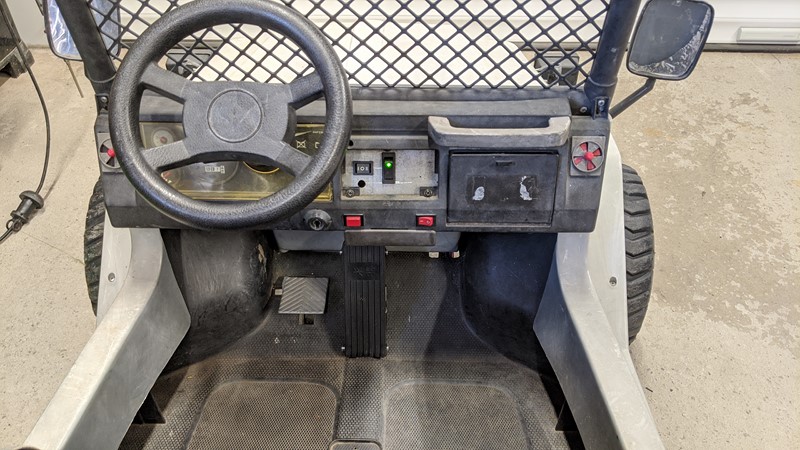
The interior modifications are pretty subtle and easily reversed. Along with the horn, the original Perego lighting harness and switches have been connected to the 12v system.
The verdict on the Perego Gaucho upgrade
End to end, all the changes have taken around 6 hours to install, spread over a few weekends. The result is fantastic. The difference really is chalk and cheese. The kids have already taken it for a drive ‘around the block’, and now they have a throttle response. They seem to be far more cautious.
It’s pretty quick now, even with both kids in. The maximum duty is currently limited to 83%. Despite trying, I couldn’t limit it to 88% duty despite best efforts! It’s great tarmac and can now drive on the grass. Perhaps a little more torque would help as it struggles on long grass or big hills, but at least I don’t have to push anymore!
The batteries are still running out pretty quickly, but there are many power source options with a more conventional 12v electrical system. Maybe a bespoke LiPoFe4 battery pack? Or perhaps a couple of Makita 18v batteries and a voltage regulator. I guess the ultimate would be to take the 36v drive system from an electric bike and give the car some real power, but I suspect that might not go down too well!
M
NEXT – Upgrading the Gaucho to LEDs
BACK to Electronics Articles

Wow, sure you can be let loose on the full size rangie now, well done
Hi!
I have done pretty much same thing with my kids gaucho. The only thing I couldn’t sort is the pedal. Can you please let me know how did you made that or where you bought it?
Hi Marcin,
The pedal came from China and was ordered through eBay. The listing was titled “Electric Throttle Accelerator Foot Pedal Speed Control for Electric Scooter” and is still available on eBay https://www.ebay.co.uk/itm/292681081822
Hope that helps
M
Hi, can I ask you what batteries are fitted? I have the same model refurbished but it goes slow especially in first gear and I would like to understand if the batteries are poor or the engines are old by now. A thousand thanks
Hi Gian, I use a set of 12v 7Ah sealed lead-acid batteries in parallel to give 14Ah at 12v. The controller board limits this to about 9v at the motors. On level pavement, the car flies along, but not for very long. The next step for me will be to upgrade to Lithium-Ion batteries. I’ve also found you can buy new motors and gearbox assemblies for around €40, so I may put some 12v or 18v motors in and a bigger battery. I hope that helps! M
Hi M, thanks for your reply.
Honestly I am not so expert and I only know that my car, as original version, has two batteries 6v 12 Ah with two motors 6V also. I don’t know now if change the batteries or the motors, from which to start. Mmm…
Hi M, I also improved the 2007 gaucho which was defective. It was necessary to install 3 x 12v batteries and connect them in parallel, replace all switches and clean the contacts on the motors, replace the faulty radio, replace the headlights with LED bulbs, install complete turn signal light system with led bulbs, install LED fog lamps, install LED reversing lamp and connect to the reversing alarm signal, install flashing 2×4 LED bulbs in the spotlights above the seat, install 2×4 LED bulbs with continuous light in the same housings, install 3 music chips (YSJ-12S, which contains 12 songs, police siren and barking dog), paint the body, make new stickers, install a rubber spring to return the drawer, install control LED lamps for each system on the control panel (control of left and right turn signals, headlights, fog lights and battery charge). All I have left to do is get a rear-view mirror, sew up seat covers and rubber wheels.
Wow that sounds amazing. Pretty sure my kids would love it. Do you have any pictures?
M
I would be grateful if you could send me a link for the motor controller because I couldn’t find it and I will need it for some other project, thanks …..
https://www.aliexpress.com/item/32853920893.html
This is the exact one I bought on AliExpress. Listed as “PWM speed controller DC motor Digital display 0~100% adjustable drive module Input MAX60A 12V 24v”.
I hope that helps!
M
Hello, great project. I am looking to do the same, can you please give more details on how to wire the pedal. thanks in advance. I ordered this on ebay: https://www.ebay.co.uk/itm/334263657027?hash=item4dd3aaa243:g:zfMAAOSwOa1hwtlv&amdata=enc%3AAQAHAAAA4K4Fb5gaCCZnqITTzEA%2FfnTbHx%2FRUus73p7gwO%2FACPIkS2iBpuK70wd%2F09XECxO2jCiHK%2FKa46cIKsps19x8syPny%2Bm7puXFwZZ3el1djtJ17PdNr4nJvh9AXl655wi3VpPZwjxpRFFJaglev3gSz3uq%2Bzmhp%2BN0MXGldOst7orLi3XZNBuBWqGoS73MPGEvl2c%2FKPAO2A5MplzCROYRpxPuIENVrXipatOlH2stKMZCXV3i0Xv3SKOyW4KuQ%2F9%2Fo7MuUpMIYtv%2B6cYuvelN6S2zHM9v2U7b1kCkQMwWJ1JH%7Ctkp%3ABFBMnvmlzaRg
The pedal goes in place of the three-wire connector that originally goes to the rotary knob. The two-wire connector to the rotary knob is a cut out for the main relay. I left this installed so that I had a secret override switch to stop the kids from trying to drive off while the batteries were on charge.
Hope that helps
M
For some reason I couldn’t get the pedal to work. I tried every possible combination to the wires. It does work only at one combination but it doesn’t turn the motor at full speed. I don’t know what am I doing wrong. Also I tried switching the magnet.
Hi Jhon, the limitation is down to the way the controller is configured/made. In the article, I mention, “The maximum duty is currently limited to 83%” this will be why you don’t get full speed. In my case, I have 6v motors and a 12v battery, so this 83% limit actually helps to protect the motors by only giving ~10v. I guess it you’re on 6v motors, it might be time for 12v batteries, or even 18v batteries if you’re on 12v motors.
Hope that Helps
M
I have the 24v gaucho. When I hook the controller to the motor and use the in build potentiometer it works great. But with the pedal it is not nowhere near 80%. More like 10%
Brilliant help I’ve got the same model gaucho for free in non working state so will take your advice. Only query is do you retain the gearstick, with speeds 1/2 and reverse or is that taken out of the system?
Hi Sam, the Perego now only has one speed (flat out), and reverse. The original direction selector that came with the motor controller gives forwards and reverse. There is nothing on the floor (no gear stick or switches) and I’ve just left the switch holes open for any water to drain out. The Perego lives outdoors all year, and so far, no problems. I still have all the original parts, so it could be returned to standard with little to show for the conversion.
Hope that helps
M
Cheers man…I’ve got it all set up and working but the throttle minimum voltage at fully off is 0.9v, which rises to 3.8v at full throttle. This causes the motor to run at 17%, rising to 85% at full throttle. Obviously this means the wheels never stop even at fully off throttle….do you have a fix for this at all? Looking online Ive not found a solution so far!
Hi Sam, I have a similar problem, but seemingly not as bad. The minimum throttle position is around 10% max for me, which isn’t enough to move the Perego forwards empty or with the kids in. It’s not great and will flatten the battery faster, but the family were somewhat keen for me to get it back on the road for them. To cut the throttle input below 1v, you could use an Op-amp in comparator mode (TL071 for example), this was my plan. And for the max voltage, well I’m driving 6v motors with a 12v supply, so I’m happy to have the full throttle power limited.
Hope that helps!
M
Would love to know what LED lights you got and also if you had any suggestions for the lights at the front? I’ve received a non runner free of charge but suspect it needs new lights all round. Also interested in what connectors I might need for the wiring as I suspect I might need to redo it all!
The lights discussed in https://bxproject.co.uk/blog/peg-perego-gaucho-upgrading-leds/ and used at the rear are 3/4″ LED marker lights (12v). There are loads of options on Amazon or eBay (https://smile.amazon.co.uk/Indicators-Waterproof-Clearance-Trailer-Markers/dp/B09WTYHFFT). For the front, I just changed the 6v bulbs to 12v LEDs (https://smile.amazon.co.uk/Indicators-Waterproof-Clearance-Trailer-Markers/dp/B09WTYHFFT). Most of the connectors are 6mm spade connectors, so easy to source.
M
Thanks for that. Unfortunately one of my light housings at the front is completely broken so. I’m going to wholesale replace with an LED housing. I think I’ve found some 3″ diameter led fog lights on amazon which might do the trick but they’re rather deep.